Nijiru - Enjoy The Savory Taste Of Japanese Umami With Vegetables!

Umami is a delicious and savory taste that was first discovered in Japan. One example of umami is the savory flavor found in dashi stock. Today we introduce Nijiru, a Japanese restaurant where you can taste this umami flavor.
What Exactly is Umami?
Have you ever heard of umami, a taste that was first discovered in Japan?
Umami is a flavor caused by the interaction of glutamates (a type of amino acid) found in food, with taste receptors on the tongue. Sometimes referred to as the fifth taste, along with the other four basic tastes of sweet, sour, salty, and bitter.
The umami flavor is best exemplified by the rich and savory taste of dashi stock, made from kombu seaweed and katsuobushi (dried bonito flakes).
Today we'll introduce a washoku (Japanese-style)restaurant known as Nijiru. At Nijiru, they use konsai nijiru (*1) throughout their menu, allowing guests to fully enjoy this umami flavor!
*1 konsai nijiru: a soup stock made from konsai (root vegetables) like Japanese daikon radish, carrots, and gobo (burdock root).
Nijiru, a Japanese Restaurant With Plenty of Vegetables

Nijiru is located just two minutes on foot from Tokyo Metro's Kudanshita Station. The fashionable indigo blue curtain hanging at the entrance gives the shop both a stylish and Japanese-style appearance.
The owner here believes that delicious and healthy is the starting point for Japanese cuisine, and asserts that konsai (root vegetables) in particular have played an important role in the origins of Japanese food.
It's highly possible that no group of people in the world have originally eaten as much konsai as people in Japan have.
Starting with nimono (simmered dishes) and miso soup, everyday cuisine contains an assortment of root vegetables like carrots, burdock root, daikon (radish), and renkon (lotus root).

With root vegetables, the area between the skin and the flesh concentrated with umami and fragrance. Each part of the vegetable offers a slightly different taste.
When these vegetables are boiled and simmered for a long time, there is an an abundance of umami and nutrients in the extracted essence.
At Nijiru, this root vegetable soup stock is used in a variety of ways, in the meat and fish sauces, salad dressings, and other dishes. This is ideal for health-conscious individuals and for those wanting more vegetables in your diet.
Also, the lunch (served on a tray called a gozen) menu is also available in English, so you can place your order without any worries.
A Special Dish Filled with Umami Flavor
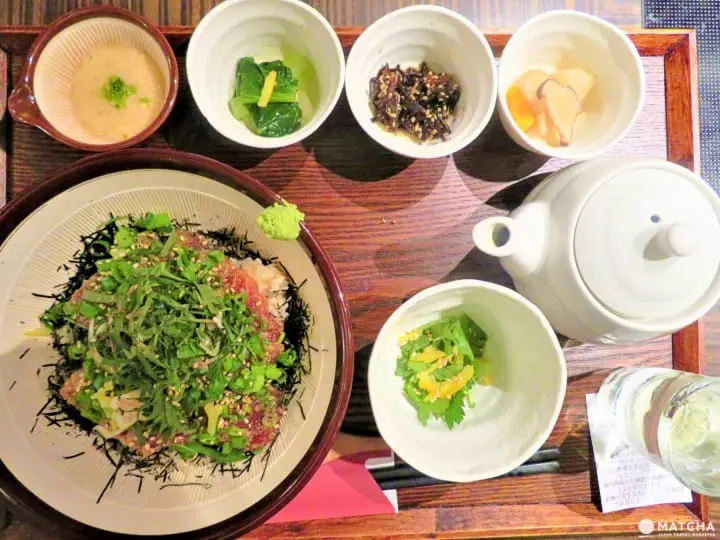
This specialty entree contains a generous amount of root vegetable soup stock. It is called maguro no goma shoyu-koji donburi, okkake konsai nijiru dashi ochazuke gozen (1,000 yen plus tax).
Next we introduce the owner's philosophy on the most delicious way to eat, which is included in the above dish's long, long name.
Begin With Root Vegetable Soup Stock
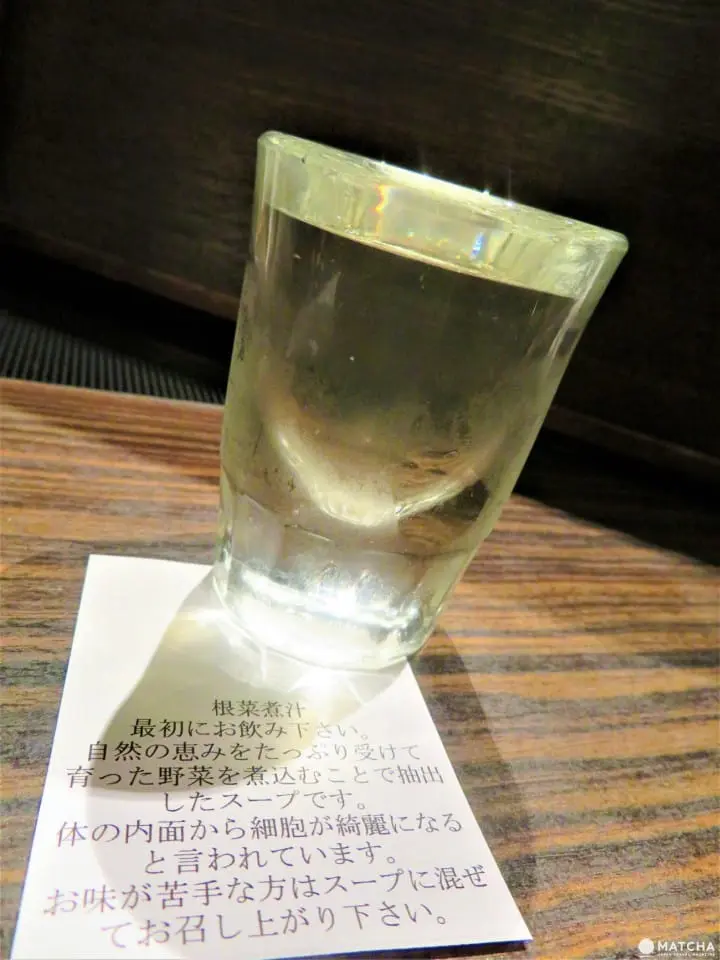
The ingredient pictured above makes an appearance throughout the gozen menu.
Though it looks like water, it's actually root vegetable soup stock (konsai nijiru). It's used in all the dishes on the menu at Nijiru, and is a stock created by slowly simmering root vegetables such as gobo (burdock root), carrots, Japanese daikon radish (both leaves and stalk), and dried shiitake mushrooms.
Let's give this a taste, just as it is.
This chilled soup stock gives off the fragrance of root vegetables and has a slightly sweet taste.
The paper sitting underneath the glass has a message on it that reads, It's thought that if you drink this kind of soup stock, you will cleanse your body, from the inside out..
Though it might be tempting to drink all of this in one quick gulp, please don't! We'll explain at the end of this article.
Let's Try the Maguro Tuna Donburi
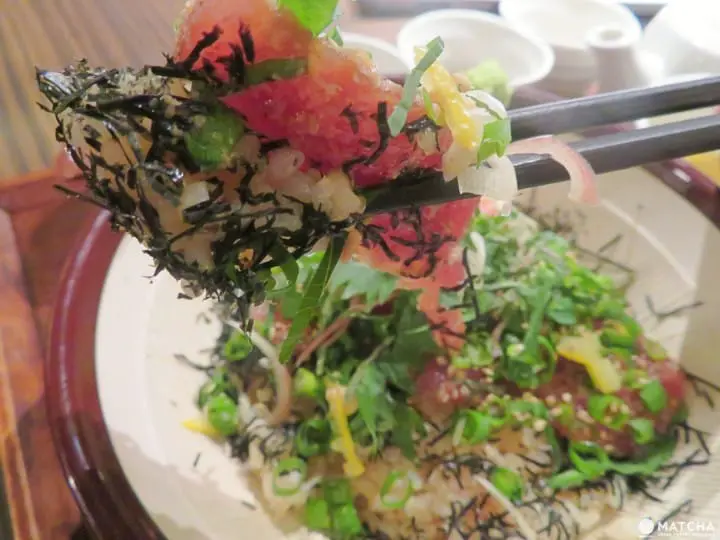
Next is the maguro tuna donburi entree. Placed atop a bed of genmai (*2) are many pieces of sashimi that have been fermented in shoyu koji (*3).
First of all, we'll sample this dish as a donburi. The umami and sweetness of the shoyu koji mixes well with the maguro tuna, and pairs perfectly with genmai. You'll find yourself wanting to eating more and more.
Although shio (salt) koji is more commonly used than shoyu koji and more well known in Japan, shoyu koji actually contains ten times more umami ingredients.
*2 genmai: rice before it undergoes a special polishing process to become white rice. With genmai, only the husk of the rice grain is removed, leaving the outer bran and germ intact, so it's very high in nutrition.
*3 koji: a type of starter that works like a yeast to ferment various kinds of food. The process begins by adding a fermentation culture (koji-kin) to steamed rice, soybeans and grains. The end product is koji, which allows for the production of miso, shoyu, vinegar, mirin (cooking wine), and other foods .
From Donburi to Ochazuke!
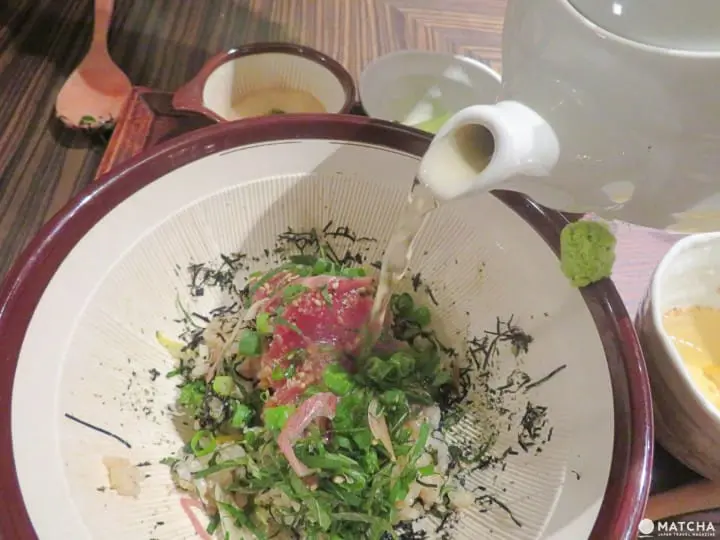
After finishing off about half of the donburi, add some dashi made from root vegetable stock and katsuo (bonito tuna flakes) to eat this ochazuke-style.

After the steaming hot dashi soup is poured over the donburi, the heat makes the tuna pieces look a bit like fat-marbled beef. You won't be able to get enough of the thick texture of this ochazuke.
The dashi's umami flavor permeates throughout the tuna, and this dish now shows off a completely different flavor and appearance from that of the donburi.

If you pour the dashi into the side dish (see above picture) containing mitsuba (*4) and yuzu (*5), it makes for a delicious-tasting soup.
There was a lot of volume to this gozen lunch entree, but our writer ate it all quickly!
*4 mitsuba: a parsley-like Japanese wild herb that's used in hot pot cooking and soups.
*5 yuzu: a lemon-like citrus fruit that's widely cultivated in Japan.
Finally Drink the Glass of Soup Stock...
Lastly, take of the leftover root vegetable soup stock in the glass. After taking one sip you will find it to be sweet! Compared to when we first took a drink, the broth has a surprisingly sweetened taste.
According to the owner, eating food containing root vegetables helps to fine tune your tongue, so that later on you can really pick up on the umami flavor.
Instead of drinking the soup stock in one gulp, sip on it gradually during your meal and enjoy the subtle changes in flavor!
A Side Menu with Many Options

In addition to the gozen meal entrees, there's a full selection of side dishes. Today I decided to order the satoimo fried potato (taro fried potato) (580 yen plus tax).
These fried potatoes were covered in a special sauce made with root vegetable stock and shoyu (soy sauce) before they were deep-fried. They taste great just the way they are without dipping sauce.
The outside of the fries are crispy and do not have a sticky texture, so we recommend them to those who don't like the gooey, sticky texture that the satoimo potatoes usually have.
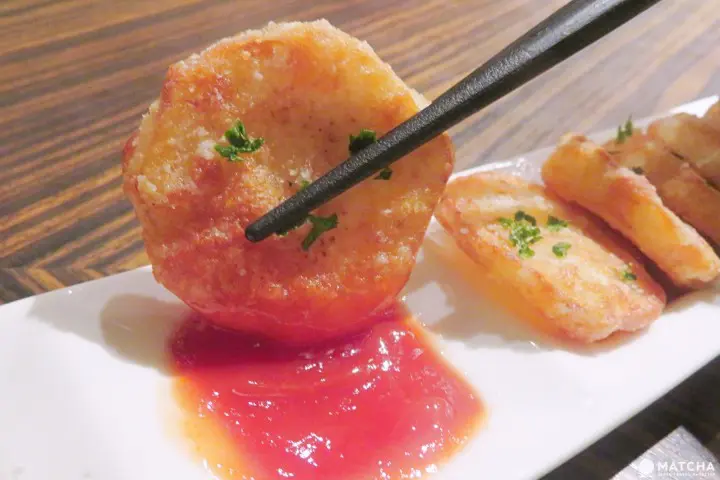
Compared to other potato varieties, satoimo have a high water content and are low in calories. Please give these a try if you're someone who'd like to eat healthy fries!
There's a full selection of side dishes utilizing root vegetable soup stock, including vegetable stock dashi rolled egg omelette (680 yen plus tax), and chicken teriyaki (680 yen plus tax).

At Nijiru, there's also a variety of carefully selected domestic nihonshu (90 ml: 580 yen plus tax, 150 ml: 980 yen plus tax).
The shop owner will gladly recommend the nihonshu that best matches your meal, so visitors unfamiliar with nihonshu can also enjoy a drink.
With one visit to this shop you'll discover of the origin of Japanese cuisine and umami flavor.
For your next lunch or dinner destination why not try stopping in at Nijiru?
In cooperation with Nijiru
海と山とお酒が大好きです。よろしくお願いします☺︎




































![[JR KYUSHU HOTEL Blossom Oita] A hotel directly connected to Oita Station - A comprehensive guide to access!](https://resources.matcha-jp.com/resize/720x2000/2025/10/23-247814.webp)

![Deep dive into Japanese brands! A tour of famous leather shoe stores with GENSEI & Nin [Harta Edition]](https://resources.matcha-jp.com/resize/720x2000/2025/12/18-253277.webp)
